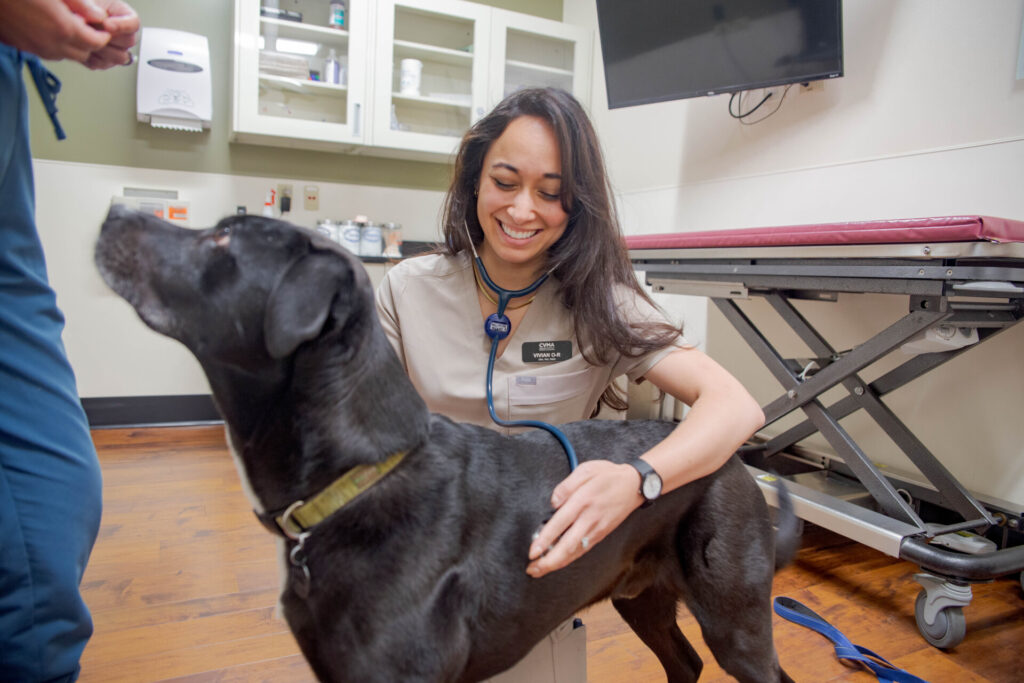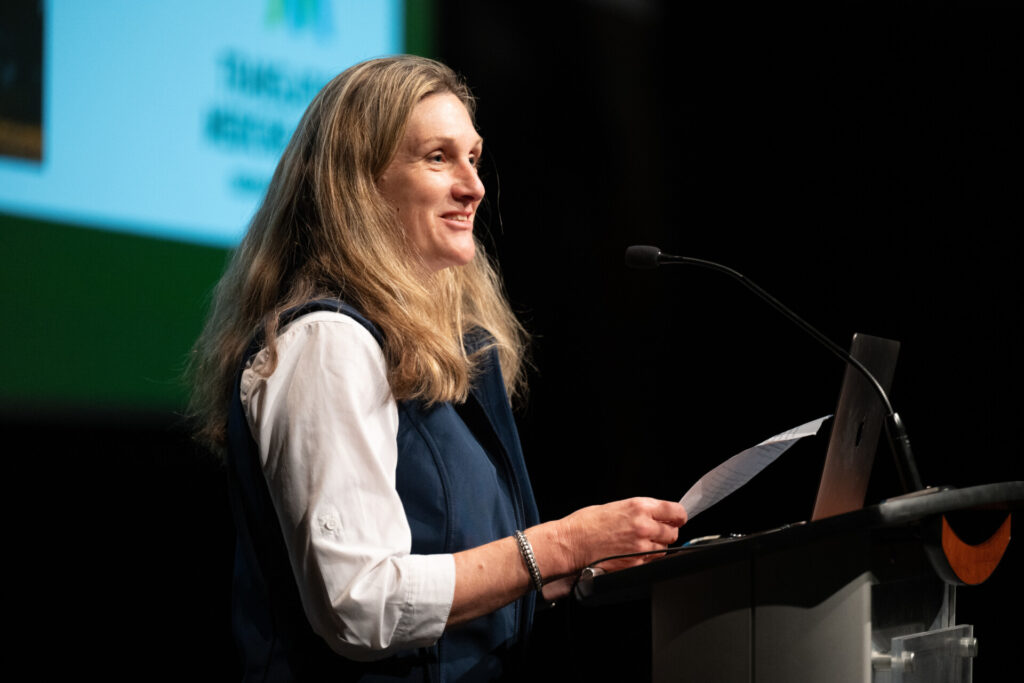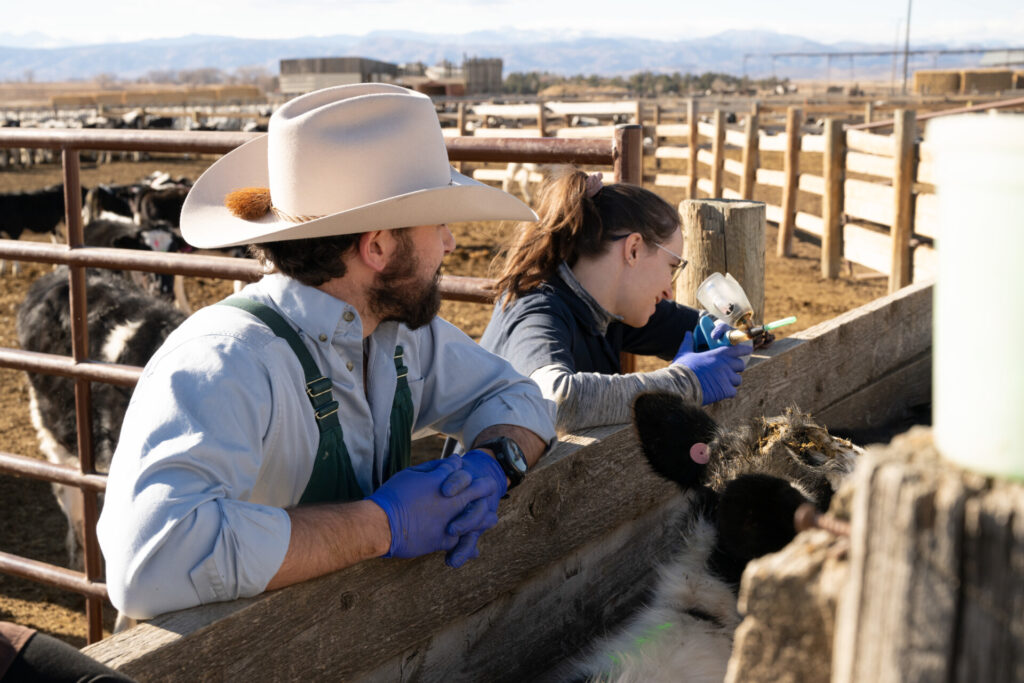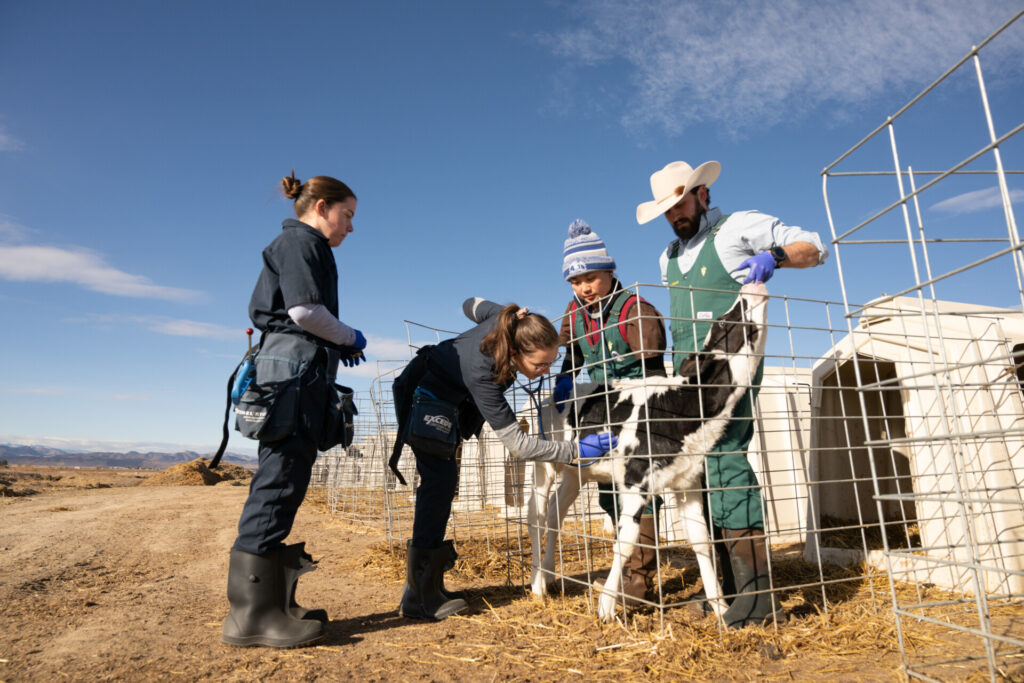
by Christopher Outcalt | The SOURCE
A few months after graduating from Colorado State University’s College of Veterinary Medicine and Biomedical Sciences in 2023, Dr. Caitlin Daimon went to work part-time at a corporate-owned small-animal clinic in Greeley. Daimon had carefully considered how she wanted to start her career, practicing two days a week in Northern Colorado, picking up the occasional relief shift, and maintaining a freelance medical writing gig she could work remotely.
Daimon, who grew up in Hawaii and earned her undergraduate degree in Pennsylvania, had been drawn to Fort Collins for CSU’s expertise in biomedical research and translational medicine. She spent eight years earning her combined Doctor of Veterinary Medicine and doctoral degree. Many of Daimon’s classmates had followed the more traditional four-year path, and so by the time Daimon graduated, they’d already begun navigating the stressors and demands of working in a new profession.
During her first few months in practice, Daimon was mindful of the rhythms of her new clinic, how it felt both familiar and approachable and yet occasionally moved in ways she was unaccustomed to. Daimon regularly encountered pet owners who were having a hard time finding a vet and would thank her for seeing their animal on the same day. What’s more, patients’ financial constraints often impacted Daimon’s approach to treating an animal. Referring a client to a specialist could easily run $1,000 and might not be an option. Whenever possible, Daimon began to apply a more problem-solving point of view to her clinical work. “It’s easy to say, ‘You should go see a cardiologist,’ but that can be really expensive,” Daimon said. “I started thinking: What can I do for my patients if that’s not an option?”
This month, CSU breaks ground on a project specifically designed to meet the needs of today’s veterinary medicine industry and a new generation of highly skilled vets like Daimon — a $230 million expansion of the veterinary medicine and education facilities on the university’s South Campus. Known as the Veterinary Health and Education Complex, or VHEC, the facilities include a new Primary Care Center — a teaching hospital for routine and urgent care; a new Livestock Veterinary Hospital, fully equipped with medical, surgical and ambulatory facilities built to meet current and future demands for large animal care; and reimagined classrooms with interactive workstations.
Slated for completion in fall 2026, the complex will be paired with a significant curriculum update. The new educational roadmap maintains the rigor of a robust science-based doctoral program while emphasizing ideas such as resilience, professionalism and wellbeing. Additionally, scientific content will be organized for retention and clinical application, and students will practice hands-on skills such as surgery earlier and with more frequent repetition. With these changes, the CSU veterinary medicine program is well-positioned to be one of the most modern and progressive programs in the country.
“We want to continue our tradition as a cutting-edge academic veterinary medical center that pushes boundaries in education and medicine. This project gives us the opportunity to better educate and support our students, and meet societal needs into the foreseeable future” said Dr. Sue VandeWoude, dean of the College of Veterinary Medicine and Biomedical Sciences. “We’re really going to be setting up our graduates for success — with their practices, with their well-being; it’s exciting for our campus and for our profession.”
VHEC by the numbers
- 213,000 square-foot facility.
- New Primary Care Center.
- $50 million investment from the state of Colorado.
- 2 state-of-the-art active learning classrooms each with capacity for 200 students.
- 8 new high-tech exam simulation rooms.

More practical and primary care experience
Earlier this year, the Colorado Legislature acknowledged the importance of facility upgrades to CSU’s veterinary medicine program, committing $50 million to the VHEC project in a bipartisan bill. The bill passed in April and was signed by the governor. (A second phase of the project will modernize the existing James L. Voss Veterinary Teaching Hospital, which opened in 1979.)
“The new Veterinary Health and Education Complex will bring CSU’s world renowned veterinary medical program to a new level of excellence,” CSU President Amy Parsons said. “With the new center, we will be able to bring together the best veterinary education in the world, ground-breaking research and advanced patient care into state-of-the-art facilities. This is a top priority for the institution and will profoundly impact the university and the state of Colorado for generations to come.”
One of the pillars of the 213,000 square-foot VHEC project is a new Primary Care Center. About 70% of CSU’s Doctor of Veterinary Medicine graduates will practice primary care, and the upgraded complex and curriculum underscore CSU’s forward-thinking approach to that training.
Students will spend a total of 12 weeks on primary care rotations — interviewing pet owners, conducting exams and developing treatment plans in partnership with faculty clinicians. Depending on the scenario, doctors will either work alongside students or observe on monitors or through one-way glass outside clinic rooms. “This hands-on experience is designed to give our students more confidence,” VandeWoude said. “We want to expand their portfolios — their willingness and understanding of what they can do in a primary care setting.”
Veterinary medicine has undergone significant shifts during the past 20 years, particularly since the onset of the COIVD-19 pandemic. The number of U.S. households with a dog jumped from 38% to 45% between 2016 and 2020, according to the American Veterinary Medical Association. There has been a corresponding increase in primary care demand for dogs and other small animals. What’s more, many pet owners are now willing to spend more on medical treatment. At the same time, however, costs have increased, making it difficult for some owners to afford veterinary care of any kind.
“With the huge spike in dog adoptions during COVID came an increased demand for veterinary medicine; that’s now the new normal,” said Dr. Chad Johannes, director of CSU’s Veterinary Teaching Hospital, who is helping oversee the opening of the university’s new Primary Care Center. “With this new project we are proactively addressing challenges that are facing our profession.”
One of the goals of the new clinic is to better educate students about what Johannes describes as “spectrum of care” — presenting a client with multiple choices for possible treatment. “We need to be able to work with clients depending on their needs and abilities,” Johannes said. “Yes, this option might be the gold standard, but there are other options that are very acceptable, and we’ll be giving students the knowledge and confidence to have those conversations.”
The new clinic, Johannes said, will also focus on improving access to care for Northern Colorado pet owners who might otherwise not be able to afford veterinary services. “Veterinary medicine is getting priced out of range of a lot of people,” he said. “So, can we improve access for those individuals while we’re training our students?”
Johannes has seen a lot of change in the time he’s been a veterinarian. When he was at CSU as an intern in the late 1990s, the focus was almost entirely on specialty medicine; very little attention was paid to primary care, he said. Helping CSU continue to lead in the field amid these kinds of shifts is a big reason why Johannes returned to Fort Collins in 2022.
“This is an opportunity for CSU, as a leader in vet med, to help solve some of these challenges,” he said. “That’s what motivates me every day. With the industry shifting as much as it is, we may not have all the answers, but to stay on top of these changing dynamics, we’re moving toward having some of them.”

A focus on mental health and wellness
The increased demand on veterinarians during the past several years has meant that both new graduates and clinicians who have practiced veterinary medicine for years are struggling with burnout and other mental health and wellness issues. Veterinarians are two to four times more likely to die by suicide than the general population, according to a 2019 Centers for Disease Control and Prevention study.
Dr. Matthew Johnston, professor of avian, exotic, and zoological medicine and co-chair of the college’s curriculum renewal committee, has seen the impact first-hand among colleagues and students. “We started seeing declining attendance at lecture-based courses. We’ve seen upticks in students leaving the program not for academic reasons, but for mental health reasons,” Johnston said. “I personally have colleagues who have died by suicide. I just met with a student a few weeks ago who told me he’s an alcoholic and needs help.”
Johnston, who has taught for more than 20 years, is passionate about building a curriculum that can help with these issues. He believes the program can have a significant impact by changing the way it teaches veterinary medicine. Fewer static lectures. More hands-on learning and group work. Dedicated breaks throughout the semester for reflection and restoration. “We’re not just going to give you information about mental health and wellness, we’re changing the whole system,” Johnston said. “CSU is radically flipping the script more than any vet school has done.”
Johnston is particularly excited about a move toward more collaborative learning. For example, he said, students might be asked to look over a list of microbes before class. There might be a small accountability quiz at the beginning of their next session, low stakes. Then, Johnston said, instead of a lecture, the instructor might organize small groups to discuss hypothetical scenarios involving those microbes. “Now, let’s say we’ve got a dog with diarrhea, and we can get together in groups and talk next steps, and what antibiotics you’re going to pick,” Johnston said. “So, very different learning, and we think that’s going to help with wellness maybe more than anything.”
During 2021 and 2022, the early years of the pandemic, Pamela Kemp, who’d been newly appointed as the Doctor of Veterinary Medicine counselor and manager of wellbeing programs, saw a significant need for an increased focus on student mental health. Kemp was conducting individual counseling sessions with about 25 Doctor of Veterinary Medicine students per week. She quickly realized she would not be able to help the more than 600 vet students on her own. “Those were tough years,” she said. “It just became very apparent that first year that this was a big need.”
Given her role and experience, Kemp has helped further integrate wellbeing into the new curriculum. Some of those changes have already occurred. CSU was the first vet school in the world to offer a specific course borrowed from human medicine called Healer’s Art; instead of discussing chemistry or anatomy, students focus on the pitfalls of compassion fatigue and less tangible ideas such as meaning and purpose. Having a new curriculum that values these types of conversations will be beneficial to students, Kemp said. “The structure is going to be different and more supportive,” she said. “I really hope it helps our students experience a lower baseline anxiety level.”
For his part, Johnston believes the payoff will be considerable. “We’ve done this right,” he said. “We’re giving ourselves the best chance of success, which is why we were saying we’re going to be the most progressive veterinary curriculum in the world.”

Livestock and rural veterinary shortage
In addition to training a new generation of veterinarians to practice small animal medicine, CSU aims to have an impact on livestock and equine practices in rural communities. Beginning in 2026, the VHEC project will allow the college to admit an additional 30 vet students into each class, adding more highly skilled clinicians to the workforce — a significant need in Colorado and across the country. Specific to underserved communities, there are 237 rural regions in 47 states experiencing critical shortages of veterinarians, according to 2023 U.S. Department of Agriculture data.
There are other challenges, too. Salaries are often significantly lower in rural communities than in urban and suburban veterinary medicine. “That’s a hard part of large animal medicine right now,” Johannes said. “How do you incentivize someone — even if they’re from rural America — to go back and stay when they can earn a lot more as a small animal veterinarian?”
CSU has already attempted to address this gap by partnering with the State of Colorado on a Veterinary Education Loan Repayment Program for Doctor of Veterinary Medicine graduates who agree to work up to four years in rural Colorado communities. The program, launched in 2017, initially offered $70,000 in loan forgiveness; last year, the Legislature expanded the program to offer $90,000 for up to six students.
Part of it is salary, but part of it is also community and culture, VandeWoude said. CSU already recruits students who are more likely to succeed practicing in rural areas. The college, however, is also in the process — in conjunction with CSU’s College of Agricultural Sciences — of conducting a survey to better understand the kinds of incentives and partnerships that will result in more graduates practicing rural medicine. “The vet shortages are much more acute in rural areas,” VandeWoude said. “We’re working on identifying those drivers so we can fill gaps with programs that target underlying problems.”
Dr. Melinda Frye, CSU’s associate dean for veterinary academic and student affairs, enjoyed working with large animals when she was studying veterinary medicine in Fort Collins, an experience she did not anticipate having when she first started vet school. After graduation, Frye worked as a mixed-animal vet in a small community in Idaho. She valued her time outdoors, forging connections with producers and seeing livestock get better because of her work.
Frye was eventually drawn back to Fort Collins. Now, she thinks about how she can create opportunities for current students to find their own passions in veterinary medicine. “Sometimes all it takes is one person to get a student excited. Whether it’s large animal practice, research, equine practice — that can be so impactful for our students.” Frye said. “A lot of students come in, and they think they know exactly what they want to do, and then they go off in a completely different direction. That’s what we want; I love when students come in and say, ‘I have no idea what I want to do,’ or, ‘I think I want to do this, but I’m really open.’”
The new Livestock Veterinary Hospital will also provide more opportunities to practice essential large animal skills — in high-tech lab spaces as well as in live animals — ensuring that students on clinical rotations have access to a variety of experiences both in the hospital and in the field. It’s a shift that Sarah Raabis, assistant professor in livestock medicine and surgery, is excited about. “This will really help students develop skills in primary care and improve their ability to manage cases in rural settings where resources may be limited,” Raabis said.

The future of veterinary medicine
As the need for veterinarians continues to evolve and expand — there are increasingly important roles for veterinary clinicians and researchers in areas such as public health, disaster response and food security — Frye believes the new facilities and curriculum will position CSU as a leader in veterinary medicine for the next several decades.
“Learners have changed. Our profession has changed. Society has changed. And therefore, the roles for vets have expanded tremendously,” Frye said. “We have to be very strategic about what we teach and how we teach it to make the best use of our four years with our students.”
When discussions about updating the curriculum first began around 2015, Frye said that although the college initially considered a modest approach, she felt encouraged by the enthusiasm amongst faculty to pursue something more seismic. “We decided the current framework was not amenable to the transformational change that needed to be made,” Frye said. “We had to do away with the old construct. That took commitment and courage on the part of everyone involved. The faculty have been tremendous; this would not have happened without their investment.”
“The significance of this project extends beyond the new, state-of-the-art facilities that will keep CSU at the forefront of veterinary education and research,” said CSU System Chancellor Tony Frank. “The Veterinary Health and Education Complex will also play a critical role in meeting the statewide need for more veterinarians with the technical and emotional skills to care for animals and support those who share their lives with them.” Frank added, “Congratulations to the campus leaders, university partners and elected officials whose vision and creativity made this groundbreaking possible.”
Although things will continue to change, VandeWoude said, the VHEC project and new curriculum will ensure that CSU can train the next generation of veterinarians regardless of the scenario. “We will be equipping our students to perform in an array of professional roles in a changing professional landscape,” VandeWoude said. “This will really help us educate and support our students well into the future.”

Support Northern Colorado Journalism
Show your support for North Forty News by helping us produce more content. It's a kind and simple gesture that will help us continue to bring more content to you.
BONUS - Donors get a link in their receipt to sign up for our once-per-week instant text messaging alert. Get your e-copy of North Forty News the moment it is released!
Click to Donate
